Lawn edging stones enable the robotic mower to truly mow right to the edging, so that absolutely no blade of grass is left standing. But how wide should your lawn edging stones be? Since there are differences between the robotic mower models, I have dealt with this topic in detail.
How wide should lawn edging stones be? Depending on the model of robotic mower and the situation, lawn edging stones should be between 4 and 10 inches wide. The decisive factor here is what is bordering the lawn edging stones on its outer side. Having a wall versus a flower bed makes a difference here.
The width of the lawn edging stones, also called mowing edging stones, depends on the model of the robotic mower that mows your lawn, and on the border behind the lawn edging stone. Depending on whether there is a wall behind it or a level flower bed covered with bark mulch, you’ll need a different width of lawn edging stone. It is also possible to combine lawn edging stones with other materials, the choice of which is again limited by the model you use.
Contents
What width should lawn edging stones for robotic mowers have?
The ideal width of the lawn edging stones depends on the model of robotic mower, as well as on the area or object the lawn edging stones are bordering. First of all I will explain to you what difference the model of your robotic mower makes.
Since choosing the correct width of lawn edging stones depends on the model of your robotic mower, you should only select your lawn edging stones after you have already decided on a robotic mower. In the long term, you can also leave a little more room for maneuvering with larger lawn edging stones if you are considering buying a larger model at some point in the future.
Today’s robotic mowers have a so-called safety distance between the body and the mowing unit, so that if the robotic mower approaches a person, the risk of injury to the person is as small as possible.
This safety distance ensures that the robotic mower, even if it drives as far as possible to the edging of the lawn, cannot mow right up to the edge. To do this, it must drive a little beyond the edging of the lawn. The size of this distance depends, of course, on the width of the safety distance. In the graphic below you can see an example of how this distance is created -here on the Automower 450X. The safety distance is roughly calculated by dividing the width of the body minus the width of the mower by 2. So:
(width of bodywork – width of mower) / 2
So the area which the robot cannot mow at the edge is result of this equation, plus a half inch or so, because otherwise the robot will hit the edging.
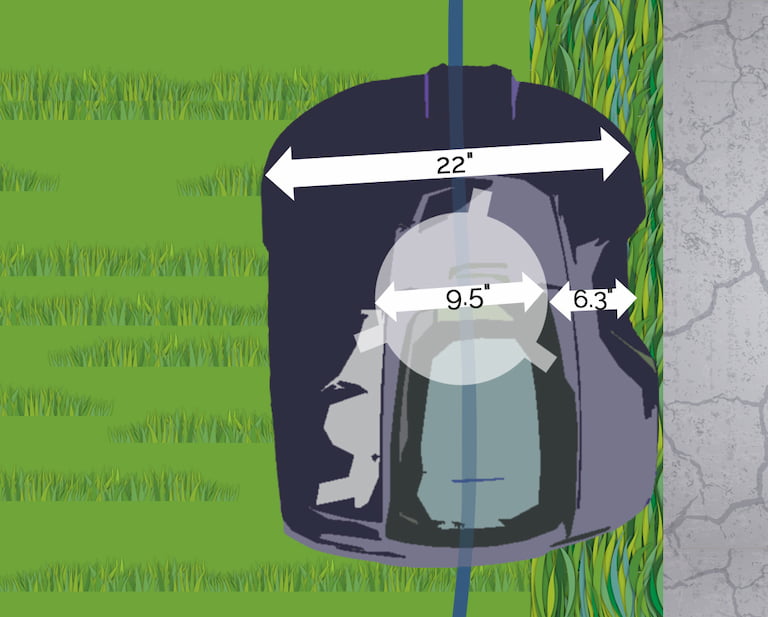
Due to the safety distance between the body and mowing unit, and the wall on the right side, the robotic mower cannot mow the lawn strip on its right side.
This therefore explains why different distances are needed for different models. Let us now turn to the second factor, namely the type of boundary material that is in place.
Perhaps you have read somewhere that you should choose the distance between the boundary wire and the edging according to what type of barrier you use to mark the boundary of your lawn. I will briefly explain it here again anyway.
First of all, you should know that the robotic mower does not stop at the boundary wire, but goes a bit beyond it. Depending on the model, this can be up to about 12 inches.
- Along paved paths or similar, the distance can therefore be very small, perhaps 2 inches, as the robotic mower simply drives onto the path and thus reaches the edging with its blades.
- Along flower beds or gravel paths, an average distance of approx. 8 inches is usually chosen to prevent the robotic mower from accidentally mowing the flowers, or gravel getting into the mowing unit
- Along walls, trees, fences and all other solid objects, as well as open waters like ground-level pools or ponds, a large distance is chosen so that the robotic mower does not slam into the tree or dip its toes into the pool every time.
If you do not have lawn edging stones, the robotic mower will completely trim the edge in the case of a paved path, but in the other two scenarios listed, a strip of grass will remain.
This means that a lawn edging stone is not necessarily required along paved areas – depending on the situation, you can of course also lay some for a uniform look. Otherwise, the ideal width of the lawn edging stone depends on which of the two cases is concerned. In a flower bed, the lawn edging stone can be about 4 inches narrower than it can be if it’s against a wall, provided that the robotic mower can drive a small way into the flower bed.
I have compiled a list here of how wide the lawn edging stone should be, either as a boundary to a wall, or if the robotic mower has room to drive a little further. The values are approximate, so you don’t have to choose stones exactly in the recommended size. Rather, use this list as a rough guide.
Minimum width of the lawn edging stones:
Fixed obstacle/ground level boundary with passing the edging
Husqvarna
- HUSQVARNA Automower 115H 7.5 Inch / 3.5 Inch
- HUSQVARNA Automower 305 7.1 Inch / 3.1 Inch
- HUSQVARNA Automower 310 8.7 Inch / 4.7 Inch
- HUSQVARNA Automower 315 8.7 Inch / 4.7 Inch
- HUSQVARNA Automower 315X 8.7 Inch / 4.7 Inch
- HUSQVARNA Automower 430X 9.3 Inch / 5.3 Inch
- HUSQVARNA Automower 430XH 9.3 Inch / 5.3 Inch
- HUSQVARNA Automower 435X AWD 9.5 Inch / 5.5 Inch
- HUSQVARNA Automower 450X 9.3 Inch / 5.3 Inch
- HUSQVARNA Automower 450XH 9.3 Inch / 5.3 Inch
- HUSQVARNA Automower 535 AWD 9.5 Inch / 5.5 Inch
- HUSQVARNA Automower 550 9.3 Inch / 5.3 Inch
- HUSQVARNA Automower 550H 10.7 Inch / 6.7 Inch
Worx
- WORX Landroid L 20V WR150 (with edge cutting feature) 3.4 Inch / 0 Inch
- WORX Landroid L 20V WR153 (with edge cutting feature) 3.4 Inch / 0 Inch
- WORX Landroid M 20V WR140 (with edge cutting feature) 2.95 Inch / 0 Inch
- WORX Landroid M 20V WR143 (with edge cutting feature) 2.95 Inch / 0 Inch
Robomow
- ROBOMOW RC306 (with edge cutting feature) 2.55 Inch / 0 Inch
- ROBOMOW RS612 (with edge cutting feature) 2 Inch / 0 Inch
- ROBOMOW RS622 (with edge cutting feature) 2 Inch / 0 Inch
- ROBOMOW RS630 (with edge cutting feature) 2 Inch / 0 Inch
- ROBOMOW RX20 (with edge cutting feature) 3.7 Inch / 0 Inch
Ambrogio
- AMBROGIO L200 Carbon Blackline 9.3 Inch / 5.3 Inch
- AMBROGIO L250i Elite GPS 7.15 Inch / 3.15 Inch
- AMBROGIO L350i Elite GPS 5.35 Inch / 1.35 Inch
- AMBROGIO L400 5.55 Inch / 1.55 Inch
- AMBROGIO L60 Deluxe 5.2 Inch / 1.2 Inch
- AMBROGIO L60 Elite 5.2 Inch / 1.2 Inch
- AMBROGIO L85 Elite 5.95 Inch / 1.95 Inch
McCulloch
- MCCULLOCH ROB R1000 8.3 Inch / 4.3 Inch
- MCCULLOCH ROB S400 7.35 Inch / 3.35 Inch
- MCCULLOCH ROB S600 7.35 Inch / 3.35 Inch
Honda
- HONDA Miimo HRM310 9.5 Inch / 5.5 Inch
- HONDA Miimo HRM520 9.5 Inch / 5.5 Inch
MowRo
- REDBACK POWER RM18 9 Inch / 5 Inch
- REDBACK POWER RM24 9.25 Inch / 5.25 Inch
And this is what the whole thing could look like, to stick with the above diagram.
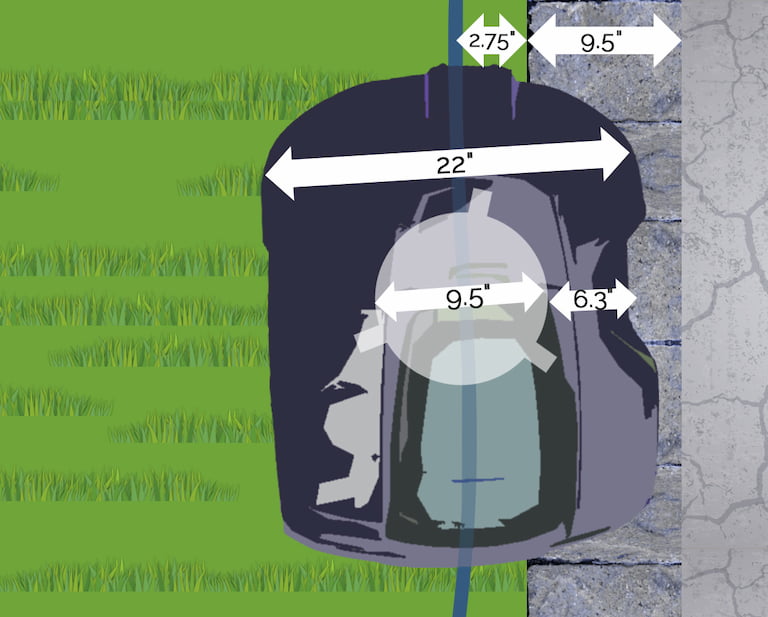
Due to the ground level lawn edging stone with a width of 8 inches on the right, the robotic mower can drive so far over the lawn edging that it can mow every last blade of grass with it.
Tip: If you want to adjust the width of your lawn edging stone so that it is only as wide as necessary corresponding to the type of boundary (wall, flower bed, etc.), but you do not want to use lawn edging stones of varying widths, you can also take a narrow lawn edging stone, such as dovetail stones (see below) and lay them along walls in double rows.
Robotic mowers with edging mode can use narrower lawn edging stones
Robotic mowers that have an edging mode can use narrower lawn edging stones. How exactly the edging mode works, you can read in this article. In short, the robotic mower comes closer to the edging because the mowing unit is offset to the right.
This means that you do not necessarily need lawn edging stones, at least on level boundaries, if the robotic mower can drive a little over the edging of the lawn.
At walls and fences, however, it does not come quite to the very edge, which is why lawn edging stones must still be placed here. These should then be at least 2 inches wide if you want to be on the safe side, but it is best to use 4 inches.
By the way, here you can find a current overview of all current robotic mowers with edging mode, which I would recommend.
What widths of lawn edging stones are out there?
The typical lawn edging stones are often around 4 inches wide, like dovetail stones, which are often used as lawn edging stones. You can also sometimes find these as wide as 6 inches. However, with a little creativity you can use all kinds of widths and sizes of lawn edging stones. Often you can also use stones which are meant for other purposes.
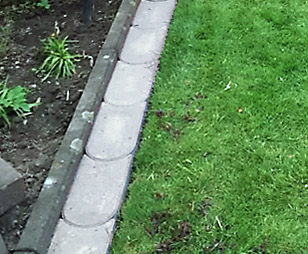
For example, 9 x 5 x 5 inch and 8 x 4 x 4 inch granite lawn edging stones are commonly found at your local hardware or gardening center, and are also often used for this purpose. You may even be able to find square cobblestones from a local stone yard or specialty lawn store. All of these sizes of edging stones are usually relatively roughly hewn, and you can also use them to create curves.
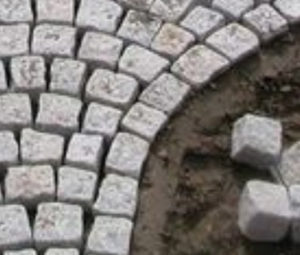
With concrete pavement slabs you can mark off very wide areas relatively easily. The standard concrete paving slab is 11-12 inches wide and is very suitable in places where the lawn edging stones border on walls or fences.
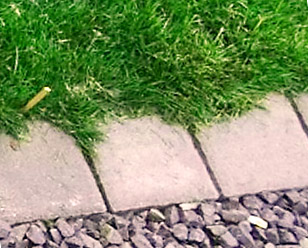
With rectangular paving stones you can also make a wonderful border for the lawn. With these you can create perfect curves. Usually such stones are 8 x 4 x 2 inches in size, but there are of course other variations in dimension. As a border, you can arrange them so that they point lengthwise towards the lawn. This also makes it possible to create beautiful curves. The joints can be grouted so that no weeds grow there.
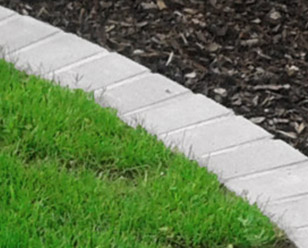
Tip: Combinations of boundary types are also visually very appealing. For example, you can lay 4-inch dovetail stones around your lawn and add a strip of bark mulch behind them in critical places such as walls or trees. With this layout, you can also vary the width of the bark mulch section.
Differences between 3-wheeled and 4-wheeled models
3-wheeled models such as the MCCULLOCH ROB R600 have only a single small rotating wheel at the front. This makes them a little more manoeuvrable than their four-wheeled counterparts, but it makes it easier for them to get stuck when driving over the lawn edging stones in gravel, bark mulch, dirt, or the like. If you have a 3-wheeled model, you should position the lawn edging stones so that the robotic mower does not drive over the stones with its front wheel.
Why are the distance of the boundary wire and the width of the mowing edging stone not the same?
A small digression, since this question sometimes arises:
The robotic mower does not stop at the boundary wire, but drives about 12 inches (depending on model) beyond the wire. This means that it drives over the cable until it is approximately in the middle of it. The distance which the robotic mower crosses over the boundary wire will determine the distance between the boundary wire and the edging of the lawn.
As the robotic mower drives over the boundary wire up to its center, it also mows a small piece beyond the boundary wire, roughly half the width of the mower deck. For this reason, the lawn edging stone does not have to be exactly as wide as the distance between the boundary wire and the lawn edging, but can be slightly smaller.
Here is the above graphic again, so that you can better understand the whole thing

Place the robotic mower down centered over the boundary wire, so it mows a bit on each side of the wire. Since the mowing unit is quite narrow, this piece is very small.
Related questions
Can I use pebbles instead of lawn edging stones or paving stones? I would rather advise against this, at least if you don’t have a clear boundary between the pebbles and the lawn, because the pebbles could be distributed on the lawn by the robotic mower while the lawn “grows into” the pebble strip. In unfavorable cases, the blades of your robotic mower could also be damaged by hitting pebbles or pebbles hitting them.
Can I also use bark mulch as a lawn border? This works quite well. In this case, I would completely remove the turf at the spot and dig a trench an inch or two deep. In any case, you should line the ground underneath the musch with a layer of foil to prevent grass from growing through. Then fill the whole thing up with bark mulch.
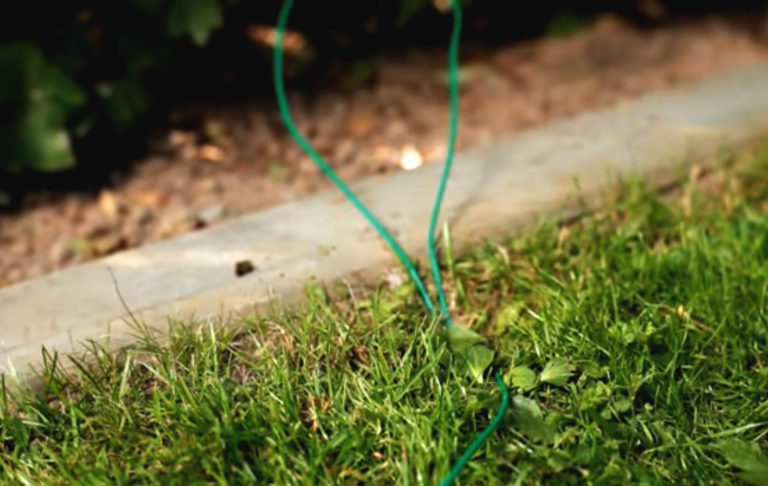
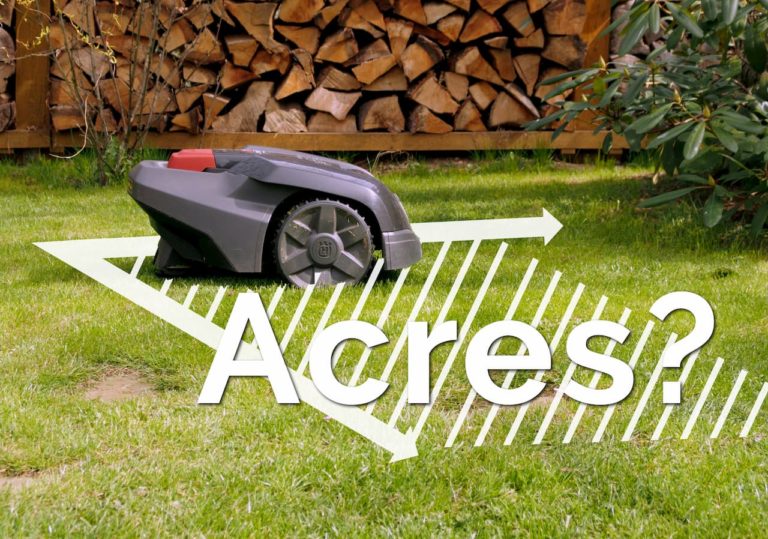
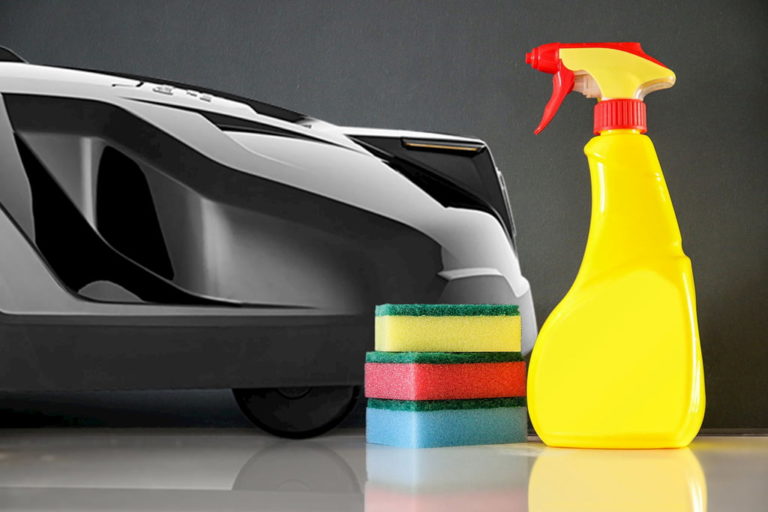


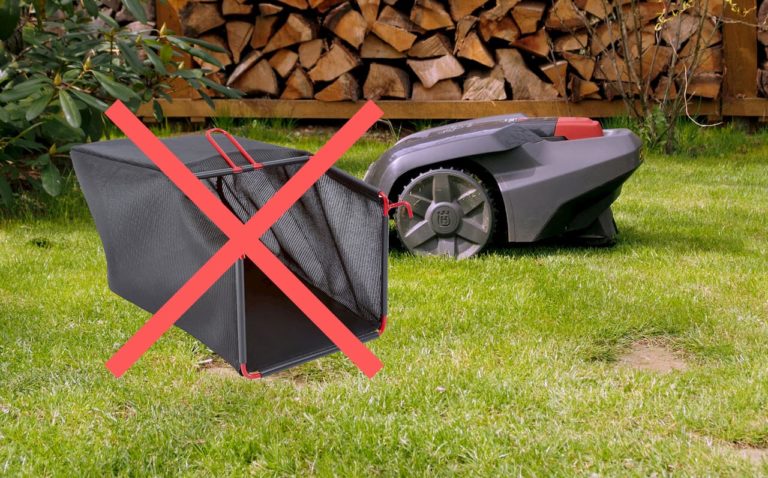
This article is insanely useful ! Thanks! I’m currently laying 3 inch edging stones next to walls etc, I’m hoping this will be enough to cut 100% of the edge with a Worx wr165e. Do you know if this should work? Or if not what edging depth should I be using?
Thanks